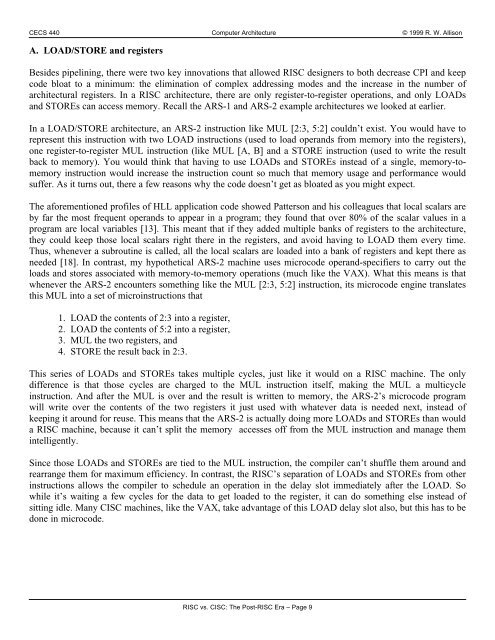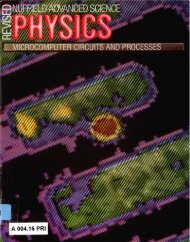RISC vs. CISC
RISC vs. CISC
RISC vs. CISC
You also want an ePaper? Increase the reach of your titles
YUMPU automatically turns print PDFs into web optimized ePapers that Google loves.
CECS 440 Computer Architecture © 1999 R. W. Allison<br />
A. LOAD/STORE and registers<br />
Besides pipelining, there were two key innovations that allowed <strong>RISC</strong> designers to both decrease CPI and keep<br />
code bloat to a minimum: the elimination of complex addressing modes and the increase in the number of<br />
architectural registers. In a <strong>RISC</strong> architecture, there are only register-to-register operations, and only LOADs<br />
and STOREs can access memory. Recall the ARS-1 and ARS-2 example architectures we looked at earlier.<br />
In a LOAD/STORE architecture, an ARS-2 instruction like MUL [2:3, 5:2] couldn’t exist. You would have to<br />
represent this instruction with two LOAD instructions (used to load operands from memory into the registers),<br />
one register-to-register MUL instruction (like MUL [A, B] and a STORE instruction (used to write the result<br />
back to memory). You would think that having to use LOADs and STOREs instead of a single, memory-tomemory<br />
instruction would increase the instruction count so much that memory usage and performance would<br />
suffer. As it turns out, there a few reasons why the code doesn’t get as bloated as you might expect.<br />
The aforementioned profiles of HLL application code showed Patterson and his colleagues that local scalars are<br />
by far the most frequent operands to appear in a program; they found that over 80% of the scalar values in a<br />
program are local variables [13]. This meant that if they added multiple banks of registers to the architecture,<br />
they could keep those local scalars right there in the registers, and avoid having to LOAD them every time.<br />
Thus, whenever a subroutine is called, all the local scalars are loaded into a bank of registers and kept there as<br />
needed [18]. In contrast, my hypothetical ARS-2 machine uses microcode operand-specifiers to carry out the<br />
loads and stores associated with memory-to-memory operations (much like the VAX). What this means is that<br />
whenever the ARS-2 encounters something like the MUL [2:3, 5:2] instruction, its microcode engine translates<br />
this MUL into a set of microinstructions that<br />
1. LOAD the contents of 2:3 into a register,<br />
2. LOAD the contents of 5:2 into a register,<br />
3. MUL the two registers, and<br />
4. STORE the result back in 2:3.<br />
This series of LOADs and STOREs takes multiple cycles, just like it would on a <strong>RISC</strong> machine. The only<br />
difference is that those cycles are charged to the MUL instruction itself, making the MUL a multicycle<br />
instruction. And after the MUL is over and the result is written to memory, the ARS-2’s microcode program<br />
will write over the contents of the two registers it just used with whatever data is needed next, instead of<br />
keeping it around for reuse. This means that the ARS-2 is actually doing more LOADs and STOREs than would<br />
a <strong>RISC</strong> machine, because it can’t split the memory accesses off from the MUL instruction and manage them<br />
intelligently.<br />
Since those LOADs and STOREs are tied to the MUL instruction, the compiler can’t shuffle them around and<br />
rearrange them for maximum efficiency. In contrast, the <strong>RISC</strong>’s separation of LOADs and STOREs from other<br />
instructions allows the compiler to schedule an operation in the delay slot immediately after the LOAD. So<br />
while it’s waiting a few cycles for the data to get loaded to the register, it can do something else instead of<br />
sitting idle. Many <strong>CISC</strong> machines, like the VAX, take advantage of this LOAD delay slot also, but this has to be<br />
done in microcode.<br />
<strong>RISC</strong> <strong>vs</strong>. <strong>CISC</strong>: The Post-<strong>RISC</strong> Era – Page 9











